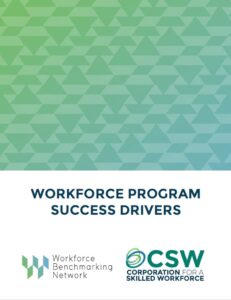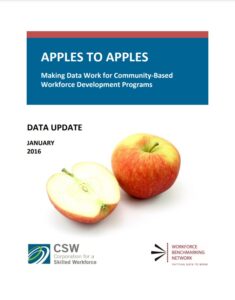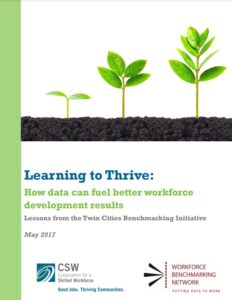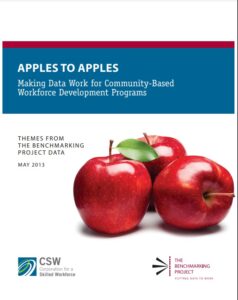The Workforce Benchmarking Network (WBN) is a collective of workforce organizations—along with public and private funders and other intermediaries—who are committed to improving their programming and outcomes through optimizing data collection and data benchmarking. Since 2008, 250+ organizations have joined the Network to gain greater insights from comparison program data, access technical assistance and peer mentorship, and drive equitable outcomes for the populations they serve. The goal of the Workforce Benchmarking Network is to improve outcomes for job seekers, employers, and communities–particularly individuals living in poverty and those affected by systemic racism and gender disparities–by ensuring that more quality data about services and outcomes are available across the field.
Who We Work With
WBN provides evidence-based tools, resources, technical assistance, and training to workforce organizations across the country to increase their program outcomes and increase equitable outcomes in their work. The Network provides a suite of services and resources, making it possible for anyone to add to our collective power to drive systems change. Anyone can access our existing resources and reports.
If you want to deepen the impact of benchmarking, consider these additional ways you can take advantage of our growing Network:
- Workforce program providers, including community colleges: consider participating in the WBN National Survey. We provide simple and accessible resources to guide you through the process.
- Funders and businesses: support capacity-building, data alignment, and metrics that matter:
- Fund a Peer Learning Cohort in communities you serve
- Sponsor a regional or national benchmarking (“Apples to Apples”) report
- Incentivize program provider WBN National Survey participation through stipends and dedicated coaching and technical support
- Workforce Intermediaries, including Workforce Boards: support your provider network by funding a peer learning cohort; build off of the cohort by funding a local benchmarking report.
- Local, State, and Federal government: leverage our resources and capacity building workshops to advance equity, improve program outcomes, continuous performance improvement, improved services, and ultimately better results for job seekers.
How We Do It
- WBN National Survey
- Peer Learning Cohorts
- Performance “Apples to Apples” Data Comparison Reports
How We’re Making Change
Workforce Benchmarking Network (WBN) National Survey
The backbone of the Network, The WBN National Survey houses the largest national dataset of aggregate info on program participants, services, and results. The Survey is a tool for workforce service providers to access and meaningfully compare program data at any scale that’s helpful, including by race, ethnicity, and gender. Participating organizations learn from and utilize collected information to improve the effectiveness of individual programs and the field as a whole. Survey participation and reports help programs tell a broader story about their impact and prioritize areas for service improvement and better data collection.
Peer Learning Cohorts
Regional and network-based providers can organize communities of practice to demonstrate collective impact, build practitioner and organizational data capacity, and identify and implement proven strategies to improve outcomes and deepen impact. These cohorts focus on racial equity and inclusion, continuous improvement tools and self-assessments, sharing of promising strategies, and individualized technical assistance. Learn more about our WBN cohorts.
Performance “Apples to Apples” Data Comparison Reports
Since 2008, the National Benchmarking Survey has collected aggregate data from more than 500 workforce programs, including participant demographics, services received, job placement and retention rates, wages, and other outcomes—resulting in the country’s largest national dataset of community-based organization outcomes. These data inform field-wide performance benchmarks—including outcomes disaggregated by race/ethnicity and gender—and illuminate program characteristics that matter for participant success.
Join 500+ workforce programs
who have participated in the
WBN National Survey
for whom—is critical for local workforce systems
and service providers.
Featured Case Study: PowerCorpsPHL
PowerCorpsPHL offers AmeriCorps work crew opportunities for unemployed or underemployed young adults in Philadelphia. After 17 weeks of training and outdoor crew participation, members can obtain further education, credentials, and work experience in the green infrastructure, electrical, solar, or urban forestry areas as preparation for jobs in those industries.
PowerCorpsPHL already knew they were recruiting fewer women than men, and that a lower percentage of women than men were completing the initial work crew phase. They decided to dive deeper into their data to understand the gender-specific issues contributing to lower outcomes with young women of color. Disaggregated data helped them answer these key questions:
- Recruitment: How many women are referred by existing community partners, and how many make it through each stage of the application process (compared to men)?
- Program retention: For each training cycle, how many women completed the program’s first phase — and how did their program’s “dismissal” rate compare to that for men?
- Employment: What industries are women entering post-program, including the targeted “green” industries — and how do women’s wages at hire compare to those of men?
With bar graphs and charts and other visualizations using disaggregated data spanning several cohorts, PowerCorpsPHL now had evidence about where women of color struggled to succeed throughout the program, from recruitment to job placement. Engaging applicants, participants, staff, and partners through focus groups and interviews helped the team better understand the stories behind the data. The team was able to identify and implement new strategies to address these influencing factors, including:
- A focus on their own staffing structure and recruitment and hiring processes, including placing more women in crew leader or assistant crew leader positions;
- Deeper engagement with community partner organizations that are led by Black women and have a strong record of employing and retaining Black women, as well as with Black women working in PowerCorpsPHL’s target industries — which has strengthened recruitment and placement networks; and
- Internal gender-specific affinity groups that allow both female and male members to discuss personal and program issues they are experiencing and get the support they need.
The results? With these strategies, supported by an increase in the program’s training stipend, female representation in PowerCorpsPHL’s cohorts has risen from 20% initially to as high as 36% in the past two years. For the first time, women have begun to obtain critical apprenticeship positions with the local water company. Staff continue to use their data, stakeholder feedback, and targeted partnerships to improve the program completion rate for women, address disparities between men’s and women’s placement wages, and to ensure that they also reach women who are returning citizens (a key part of PowerCorpsPHL’s mission).
Recent Clients & Selected Work
- Greater Twin Cities United Way
- United Way of Greater Dallas & Communities Foundation of Texas
- W.K. Kellogg Foundation – Detroit
- United Way of Greater Philadelphia and Southern New Jersey
- Annie E. Casey Foundation
- Atlanta CareerRise
- WBN Cohorts have been sponsored by local funders in: Atlanta, Chicago, Dallas-Ft. Worth, Detroit, Minneapolis-St. Paul, New York City, and Philadelphia-Southern New Jersey





